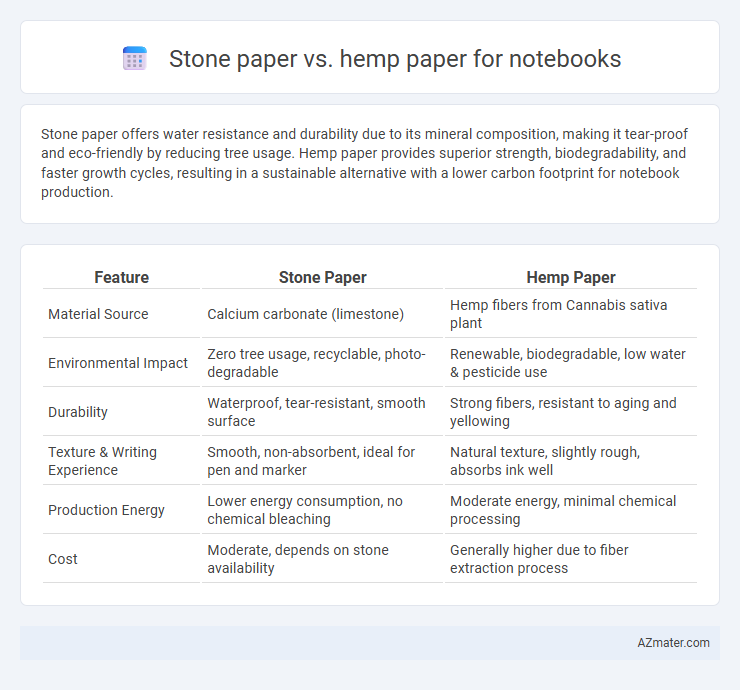Stone paper offers water resistance and durability due to its mineral composition, making it tear-proof and eco-friendly by reducing tree usage. Hemp paper provides superior strength, biodegradability, and faster growth cycles, resulting in a sustainable alternative with a lower carbon footprint for notebook production.
Table of Comparison
| Feature | Stone Paper | Hemp Paper |
|---|---|---|
| Material Source | Calcium carbonate (limestone) | Hemp fibers from Cannabis sativa plant |
| Environmental Impact | Zero tree usage, recyclable, photo-degradable | Renewable, biodegradable, low water & pesticide use |
| Durability | Waterproof, tear-resistant, smooth surface | Strong fibers, resistant to aging and yellowing |
| Texture & Writing Experience | Smooth, non-absorbent, ideal for pen and marker | Natural texture, slightly rough, absorbs ink well |
| Production Energy | Lower energy consumption, no chemical bleaching | Moderate energy, minimal chemical processing |
| Cost | Moderate, depends on stone availability | Generally higher due to fiber extraction process |
Introduction to Alternative Papers: Stone vs Hemp
Stone paper, made from calcium carbonate bonded with non-toxic resin, offers water resistance and durability, making it an eco-friendly alternative to traditional wood pulp paper. Hemp paper, derived from the fibrous stalks of the hemp plant, is biodegradable, sustainable, and requires less water and pesticides in its production. Both materials present innovative solutions for notebook manufacturing, emphasizing environmental benefits and enhanced product longevity.
Composition and Manufacturing Process
Stone paper is made primarily from calcium carbonate bonded with high-density polyethylene, resulting in a waterproof, tear-resistant material produced through a dry process that eliminates water pollution. Hemp paper consists of cellulose fibers extracted from hemp plants, processed using traditional pulping methods that involve soaking, beating, and drying, offering durability and eco-friendliness due to its renewable source. The manufacturing of stone paper involves fewer chemicals and no trees, while hemp paper requires agricultural cultivation and chemical treatment but provides excellent biodegradability.
Environmental Impact: Sustainability Comparison
Stone paper is made from calcium carbonate and uses up to 80% less water and zero trees compared to traditional wood pulp paper, significantly reducing deforestation and water consumption. Hemp paper, derived from the fast-growing hemp plant, requires fewer pesticides and grows in less time than trees, promoting soil health and carbon sequestration. Both materials offer sustainable alternatives, but stone paper's production has a lower water footprint, while hemp paper provides enhanced biodegradability and renewable crop benefits.
Durability and Longevity
Stone paper offers superior durability and water resistance compared to hemp paper, making it less prone to tearing and wear over time. Hemp paper, while biodegradable and eco-friendly, tends to be less resistant to moisture and physical damage, affecting its longevity in daily use. Notebooks crafted from stone paper typically outlast those made from hemp paper due to their enhanced strength and durability properties.
Writing Experience: Texture and Ink Compatibility
Stone paper offers a smooth, almost plastic-like texture that enhances ink flow and prevents feathering, ideal for gel pens and markers. Hemp paper provides a coarser, fibrous surface that gives a tactile resistance, favored by fountain pen users for its natural absorbency and minimal ink bleed. Both materials support distinct writing experiences, with stone paper excelling in ink clarity and hemp paper delivering a traditional, organic feel.
Water Resistance and Tear Strength
Stone paper exhibits superior water resistance due to its synthetic calcium carbonate base coated with non-toxic resin, preventing ink smudging and paper warping when wet. Hemp paper offers high tear strength, derived from long natural fibers, providing exceptional durability and resistance to ripping under tension. While stone paper excels in moisture protection, hemp paper is ideal for users prioritizing robustness and eco-friendly fiber content in notebook materials.
Cost Analysis: Production and Retail Pricing
Stone paper production involves mineral-based materials like calcium carbonate, resulting in energy-efficient manufacturing and lower water usage, which reduces overall costs compared to traditional plant fibers. Hemp paper, derived from fibrous hemp stalks, requires more intensive processing and higher agricultural inputs, increasing production expenses. Retail pricing reflects these differences, with stone paper notebooks often priced competitively due to cost-effective manufacturing, while hemp paper notebooks carry premium pricing because of sustainable cultivation and complex processing factors.
Recycling and Biodegradability
Stone paper, made primarily from calcium carbonate and non-toxic resin, offers a waterproof and tear-resistant alternative but is not biodegradable and poses challenges in recycling due to its mineral content. Hemp paper, derived from the fibrous stalks of the hemp plant, is both biodegradable and easier to recycle because of its natural cellulose composition, which breaks down more readily in the environment. Choosing hemp paper for notebooks supports sustainable waste management practices by promoting biodegradability and efficient recycling processes.
Market Availability and Popular Brands
Stone paper and hemp paper notebooks are gaining traction in the eco-friendly stationery market, with stone paper widely available through brands like Karst and ROAR Journal known for water-resistant and tear-proof qualities. Hemp paper notebooks, offered by companies such as North American Hemp and Hemper, emphasize sustainability and durability, appealing to environmentally conscious consumers. Market availability favors stone paper in mainstream retail channels, while hemp paper is primarily found in niche eco-friendly stores and specialty online platforms.
Choosing the Right Paper for Your Notebook
Stone paper offers water resistance, durability, and a smooth writing surface ideal for notebooks used in harsh environments or for long-term note preservation. Hemp paper provides superior eco-friendliness, biodegradable qualities, and a natural texture preferred by users prioritizing sustainability and organic materials. Selecting the right paper for your notebook depends on balancing environmental impact, durability needs, and writing preferences.

Infographic: Stone paper vs Hemp paper for Notebook
 azmater.com
azmater.com